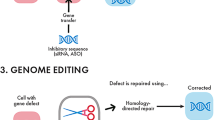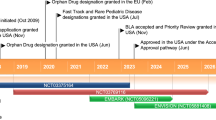Abstract
Congenital erythropoietic porphyria (CEP) is an inherited metabolic disorder characterized by an overproduction and accumulation of porphyrins in bone marrow. This autosomal recessive disease results from a deficiency of uroporphyrinogen III synthase (UROIIIS), the fourth enzyme of the haem biosynthetic pathway. It is phenotypically heterogeneous: patients with mild disease have cutaneous involvement, while more severely affected patients are transfusion dependent. The cloning of UROIIIS cDNA and genomic DNA has allowed the molecular characterization of the genetic defect in a number of families. To date, 22 different mutations have been characterized. Allogeneic bone marrow transplantation is the only curative treatment available for the severe, transfusion-dependent, cases. When bone marrow transplantation cannot be performed owing to the absence of a suitable donor, the autografting of genetically modified cells is an appealing alternative. The best approach to somatic gene therapy in this disease involves the use of recombinant retroviral vectors to transduce cells ex vivo, followed by autologous transplantation of the genetically modified cells. We investigated retroviral transfer in deficient human fibroblasts, immortalized lymphoblasts as well as bone marrow cells, and obtained a complete restoration of the enzymatic activity and full metabolic correction.
Using K562 cells, an erythroleukaemic cell line, the expression of the transgene remained stable during 3 months and during erythroid differentiation of the cells. Finally, a 1.6- to 1.9-fold increase in enzyme activity compared to the endogenous level was found in normal CD34+ cells, a population of heterogeneous cells known to contain the progenitor/stem cells for long-term expression. The future availability of a mouse model of the disease will permit ex vivo gene therapy experiments on the entire animal.
Similar content being viewed by others
REFERENCES
Bensidhoum M, Ged C, Hombrados I, et al (1995) Identification of two new mutations in congenital erythropoietic porphyria. Eur J Hum Genet 3: 102–107.
Blaese RM, Culver KW, Miller AD, et al (1995) T lymphocyte-directed gene therapy for ADA− SCID: initial trial results after four years. Science 270: 475–480.
Bordignon C, Notarangelo LD, Nobili N, et al (1995) Gene therapy in peripheral blood lymphocytes and bone-marrow for ADA-immunodeficient patients. Science 270: 470–475.
Boulechfar S, Da Silva V, Deybach JC, Nordmann Y, Grandchamp B, Verneuil H de (1992) Heterogeneity of the mutations in the uroporphyrinogen III synthase gene in congenital erythropoietic porphyria. Hum Genet 88: 320–324.
Deybach JC, Verneuil H de, Phung N, Nordmann Y, Puissant A, Boffety B (1981) Congenital erythropoietic porphyria (Gunther's disease): enzymatic studies on two cases of late onset. J Lab Clin Med 97: 551–558.
Deybach JC, Verneuil H de, Boulechfar S, Grandchamp B, Nordmann Y (1990) Point mutations in the uroporphyrinogen III synthase gene in congenital erythropoietic porphyria. Blood 75: 1763–1765.
Dunbar C, Emmons VB (1994) Gene transfer into hematopoietic progenitor and stem cells: progress and problems. Stem Cells 12: 563–572.
Eaves C, Zandstra P, Ponchio L et al (1995) Functional studies of human long-term culture-initiating cells (LTC-IC) in vitro and in vivo. In Beuzard Y, Lubin B, Rosa I, eds. Sickle Cell Disease and Thalassaemias: New Trends in Therapy. Colloque INSERM, John Libbey Eurotext 234: 589–594.
Fontanellas A, Bensidhoum M, Enriquez de Salamanca R, Verneuil H de, Ged C (1996) A systematic analysis of the mutations of the uroporphyrinogen III synthase gene in congenital erythropoietic porphyria. Eur J Human Genet, 4: 274–282.
Hoogerbrugge PM, Beusechem VW, Kaptein LCM, Einerhand MPW, Valerio D (1995) Gene therapy for adenosine deaminase deficiency. Br Med Bull 51: 72–81.
Kamel-Reid S, Dick JE (1988) Engraftment of immune-deficient mice with human hematopoietic stem cells. Science 242: 1706–1709.
Kauffman L, Evans DIK, Stevens R, Weinkove C (1991) Bone-marrow transplantation for congenital erythropoietic porphyria. Lancet 337: 1510–1511.
Kawashima I, Zanjani ED, Almaida-Porada G, Flake AW, Zeng HQ, Ogawa M (1996) CD34+ human marrow cells that express low levels of kit protein are enriched for long-term marrow-engrafting cells. Blood 87: 4136–4142.
Lapidot T, Pflumio F, Doedens M, Murdoch B, Williams DE, Dick JE (1992) Cytokine stimulation of multilineage hematopoiesis from immature human cells engrafted in SCID mice. Science 255: 1137–1141.
Larochelle A, Vormoor J, Lapidot T, et al (1995) Engraftment of immune-deficient mice with primitive hematopoietic cells from β-thalassemia and sickle cell anemia patients: implications for evaluating human gene therapy protocols. Hum Mol Genet 4: 163–172.
Larochelle A, Vormoor J, Haneberg H, et al (1996) Identification of primitive human hematopoietic cells capable of repopulating NOD/SCID mouse bone marrow: implications for gene therapy. Nature Med 2: 1327–1337.
Moreau-Gaudry F, Ged C, Barbot C, et al (1995a) Correction of the enzyme defect in cultured congenital erythropoietic porphyria disease cells by retrovirus-mediated gene transfer. Hum Gene Ther 6: 13–19.
Moreau-Gaudry F, Mazurier F, Bensidhoum M, Ged C, Verneuil H de (1995b) Metabolic correction of congenital erythropoietic porphyria by retrovirus-mediated gene transfer into Epstein-Barr virus-transformed B-cell lines. Blood 85: 1449–1453.
Moreau-Gaudry F, Barbot C, Mazurier F, et al (1996) Correction of the enzyme deficit of bone marrow cells in congenital erythropoietic porphyria by retroviral gene transfer. Hematol Cell Ther 38: 217–220.
Romeo G, Levin EY (1969) Uroporphyrinogen III cosynthetase in human congenital erythropoietic porphyria. Biochemistry 63: 856–863.
Romeo G, Glenn BL, Levin EY (1970) Uroporphyrinogen III cosynthetase in asymptomatic carriers of congenital erythropoietic porphyria. Biochem Genet 4: 719–726.
Sekhar M, Kotani H, Doren S, Agarwal R, McGarrity G, Dunbar CE (1996) Retroviral transduction of CD34-enriched hematopoietic progenitor cells under serum-free conditions. Hum Gene Ther 7: 33–38.
Thomas C, Ged C, Nordmann Y, et al (1996) Correction of congenital erythropoietic porphyria by bone marrow transplantation. J Pediatr, 129: 453–456.
Torbett BE, Conners K, Shao LE, Mosier DE, Yu J (1995) High level multilineage engraftment of human hematopoietic cells is maintained in NOD/SCID mice. Blood 86(supplement 1): 112a.
Tsai SF, Bishop DF, Desnick RJ (1988) Human uroporphyrinogen III synthase: molecular cloning, nucleotide sequence, and expression of a full-length cDNA. Proc Natl Acad Sci USA 85: 7049–7053.
Verneuil H de, Ged C, Boulechfar S, Moreau-Gaudry F (1995a) Porphyrias: animal models and prospects for cellular and gene therapy. J Bioenerg Biomembr 27: 239–248.
Verneuil H de, Moreau-Gaudry F, Ged C, et al (1995b) Porphyrie érythropoïétique congénitale. A propos d'un cas dû à une hémolyse aiguë avec insuffisance hépatique. Arch Pédiatrie 2: 755–761.
Verstraeten L, Van Regemorter N, Pardou A, et al (1993) Biochemical diagnosis of a fatal case of Günther's disease in a newborn with hydrops foetalis. Eur J Clin Chem Clin Biochem 31: 121–128.
Wanda PE, Lee LT, Howe C (1981) A spectrophotometric method for measuring hemoglobin in erythroleukemic cells (K562). J Histochem Cytochem 29: 1442–1444.
Warner CA, Yoo HW, Roberts AG, Desnick RJ (1992) Congenital erythropoietic porphyria: identification and expression of exonic mutations in the uroporphyrinogen III synthase gene. J Clin Invest 89: 693–700.
Wells S, Malik P, Pensiero M, Kohn DB, Nolta JA (1995) The presence of an autologous marrow stromal cell layer increases glucocerebrosidase gene transduction of long-term culture initiating cells (LTCICs) from the bone marrow of a patient with Gaucher disease. Gene Ther 2: 512–520.
Xu W, Warner CA, Desnick RJ (1995) Congenital erythropoietic porphyria: identification and expression of 10 mutations in the uroporphyrinogen III synthase gene. J Clin Invest 95: 905–912.
Xu W, Astrin KH, Desnick RJ (1996) Molecular basis of congenital erythropoietic porphyria: mutations in the human uroporphyrinogen III synthase gene. Hum Mutat 7: 187–192.
Zixkieffer I, Langer B, Eyer D, et al (1996) Successful cord blood stem cell transplantation for congenital erythropoietic porphyria (Gunther's disease). Bone Marrow Transplantation 18: 217–220.
Author information
Authors and Affiliations
Rights and permissions
About this article
Cite this article
Mazurier, F., Moreau-Gaudry, F., Salesse, S. et al. Gene transfer of the uroporphyrinogen III synthase cDNA into haematopoietic progenitor cells in view of a future gene therapy in congenital erythropoietic porphyria. J Inherit Metab Dis 20, 247–257 (1997). https://doi.org/10.1023/A:1005365008147
Issue Date:
DOI: https://doi.org/10.1023/A:1005365008147




